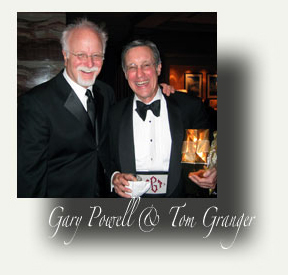When sentiment becomes idea, sometimes a larger creative palette in needed.
The Headliners Club of Austin
Celebrates 50th Anniversary
by Gary Powell, Event Producer
Click Photo at Right to Enlarge
Tom Granger, Chairman of the Board of Trustees at the Headliners Club in Austin, Texas, invited me to serve as event producer for the Austin club’s 50th Anniversary Gala held at Renaissance Hotel on January 12, 2006. The Headliners Club has a rich history with members who MAKE history and NOT just Texas history. Over 800 attendees were treated to a “roast” of White House Deputy Chief of Staff, Karl Rove, served up by Mark McKinnon, John Sharp, Mary Matalin and Lowell Leberman.
The very clever Ralph Wayne, President and CEO of the Texas Civil Justice League, 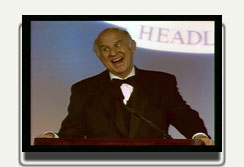 who is sort of like Bob Hope (except for being smarter, more energetic, more likeable and funnier) served as the evening’s Master of Ceremonies using his long-gone hairline as adroitly as Hope used his golf club.
who is sort of like Bob Hope (except for being smarter, more energetic, more likeable and funnier) served as the evening’s Master of Ceremonies using his long-gone hairline as adroitly as Hope used his golf club.
Tom Granger, partner of Midwikis & Granger, P.C., wrote a three-page historical summary of the club’s 50 years and Sue Meller, the club’s managing director, fed me hundreds of photos (and stories) from which to build a brief historical video documentary which we premiered at the event on two 12-foot screens. Tom is a kind and gentle human, so it was my job to make his written history match the spirit of the event which might have alternately been named “Grenades and Accolades”. Lucky, I was raised in a family who communicated by hurling quips of Mark Twain, one of the original American grenade-launching wordsmiths.
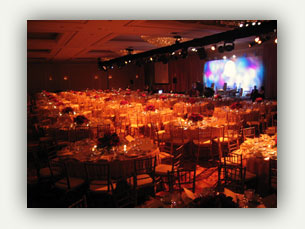 Being a composer, I looked for opportunities for an original song. The club’s motto, “Non Quis Sed Quid”, which translates “It’s not who you are, but what you are”, seemed like a perfect place to start. The song “It’s Not Who, but What You Are” was written one day, recorded and mixed the next and beautifully sung by a wonderful singer who is new to my studio, Leslie Whiteley. Leslie is a elementary music teacher in Killeen and was introduced to me by long-time friend and colleague Larry Seyer.
Being a composer, I looked for opportunities for an original song. The club’s motto, “Non Quis Sed Quid”, which translates “It’s not who you are, but what you are”, seemed like a perfect place to start. The song “It’s Not Who, but What You Are” was written one day, recorded and mixed the next and beautifully sung by a wonderful singer who is new to my studio, Leslie Whiteley. Leslie is a elementary music teacher in Killeen and was introduced to me by long-time friend and colleague Larry Seyer.
The very same Larry Seyer, who owns Texas Video Productions, brought his wonderful eye and talent to edit the 13-minute video. So, after scanning some 600 photos, writing and editing the script, recording the voice/over with the deep, resonant voice of Craig Toungate, editing and mixing for four days, the video was done. There were also interviews of members who were taped at the club’s Christmas party and there was a midnight run downtown to capture the fully orange U.T. tower with the giant #1 cascading downward. We also invested in the “west wing” of the Austin History Center for use of their wonderful historical photos of Austin. Thank you to Margaret Schlankey for her knowledge of our city, the people and year-model cars.
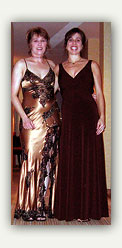 At this major Austin event we employed the trusted hostesses of the “In the Studio” concerts, Amy Person and Vanessa Joy (both full time psychotherpists), who were so helpful in smoothing attending members, guests and me AND for getting Karl Rove to dinner on time.
At this major Austin event we employed the trusted hostesses of the “In the Studio” concerts, Amy Person and Vanessa Joy (both full time psychotherpists), who were so helpful in smoothing attending members, guests and me AND for getting Karl Rove to dinner on time.
This event was an extraordinary experience for me to learn about this prestigious club’s history, but more important, work with the wonderful people who inhabit it now. I am proud to have been entrusted by all concerned especially Tom and Beth Granger, Sue Meller and the Headliners staff.
My best professional regards go out to Steve Overby, Mike Noth and the crew listed below of AVW-Telav for their outstanding work under pressure. 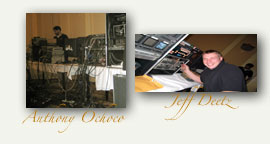 Also, thank you to Howard Fletcher of “First In – Last Out”.
Also, thank you to Howard Fletcher of “First In – Last Out”.
(Project Manager, Mike Noth / Audio Engineer, Aaron Foye / Video Engineer, Jeff Deetz / Tape Operator, Anthony Ochoco / Cam Op, Colin Jones / Cam Op, Hank Swania / Lighting Director, Ethan Balmer)
by Gary Powell, Event Producer
Click Photo at Right to Enlarge
Tom Granger, Chairman of the Board of Trustees at the Headliners Club in Austin, Texas, invited me to serve as event producer for the Austin club’s 50th Anniversary Gala held at Renaissance Hotel on January 12, 2006. The Headliners Club has a rich history with members who MAKE history and NOT just Texas history. Over 800 attendees were treated to a “roast” of White House Deputy Chief of Staff, Karl Rove, served up by Mark McKinnon, John Sharp, Mary Matalin and Lowell Leberman.
The very clever Ralph Wayne, President and CEO of the Texas Civil Justice League,  who is sort of like Bob Hope (except for being smarter, more energetic, more likeable and funnier) served as the evening’s Master of Ceremonies using his long-gone hairline as adroitly as Hope used his golf club.
who is sort of like Bob Hope (except for being smarter, more energetic, more likeable and funnier) served as the evening’s Master of Ceremonies using his long-gone hairline as adroitly as Hope used his golf club.
Tom Granger, partner of Midwikis & Granger, P.C., wrote a three-page historical summary of the club’s 50 years and Sue Meller, the club’s managing director, fed me hundreds of photos (and stories) from which to build a brief historical video documentary which we premiered at the event on two 12-foot screens. Tom is a kind and gentle human, so it was my job to make his written history match the spirit of the event which might have alternately been named “Grenades and Accolades”. Lucky, I was raised in a family who communicated by hurling quips of Mark Twain, one of the original American grenade-launching wordsmiths.
 Being a composer, I looked for opportunities for an original song. The club’s motto, “Non Quis Sed Quid”, which translates “It’s not who you are, but what you are”, seemed like a perfect place to start. The song “It’s Not Who, but What You Are” was written one day, recorded and mixed the next and beautifully sung by a wonderful singer who is new to my studio, Leslie Whiteley. Leslie is a elementary music teacher in Killeen and was introduced to me by long-time friend and colleague Larry Seyer.
Being a composer, I looked for opportunities for an original song. The club’s motto, “Non Quis Sed Quid”, which translates “It’s not who you are, but what you are”, seemed like a perfect place to start. The song “It’s Not Who, but What You Are” was written one day, recorded and mixed the next and beautifully sung by a wonderful singer who is new to my studio, Leslie Whiteley. Leslie is a elementary music teacher in Killeen and was introduced to me by long-time friend and colleague Larry Seyer.
The very same Larry Seyer, who owns Texas Video Productions, brought his wonderful eye and talent to edit the 13-minute video. So, after scanning some 600 photos, writing and editing the script, recording the voice/over with the deep, resonant voice of Craig Toungate, editing and mixing for four days, the video was done. There were also interviews of members who were taped at the club’s Christmas party and there was a midnight run downtown to capture the fully orange U.T. tower with the giant #1 cascading downward. We also invested in the “west wing” of the Austin History Center for use of their wonderful historical photos of Austin. Thank you to Margaret Schlankey for her knowledge of our city, the people and year-model cars.
 At this major Austin event we employed the trusted hostesses of the “In the Studio” concerts, Amy Person and Vanessa Joy (both full time psychotherpists), who were so helpful in smoothing attending members, guests and me AND for getting Karl Rove to dinner on time.
At this major Austin event we employed the trusted hostesses of the “In the Studio” concerts, Amy Person and Vanessa Joy (both full time psychotherpists), who were so helpful in smoothing attending members, guests and me AND for getting Karl Rove to dinner on time.
This event was an extraordinary experience for me to learn about this prestigious club’s history, but more important, work with the wonderful people who inhabit it now. I am proud to have been entrusted by all concerned especially Tom and Beth Granger, Sue Meller and the Headliners staff.
My best professional regards go out to Steve Overby, Mike Noth and the crew listed below of AVW-Telav for their outstanding work under pressure.  Also, thank you to Howard Fletcher of “First In – Last Out”.
Also, thank you to Howard Fletcher of “First In – Last Out”.
(Project Manager, Mike Noth / Audio Engineer, Aaron Foye / Video Engineer, Jeff Deetz / Tape Operator, Anthony Ochoco / Cam Op, Colin Jones / Cam Op, Hank Swania / Lighting Director, Ethan Balmer)
Larry Seyer Offers “Merry Larry Christmas”
For Free Download
by Gary Powell
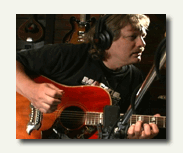
I met the guitar-playing audio engineer Larry Seyer in my first professional recording session in 1978. No need to shop around for another Larry. There isn’t one. Over one hundred albums later and we’re still doing it. As Larry’s gift to his family and fans, Larry has made his “Merry Larry Christmas” album available as a free download from his site.
(Christmas is over, now, but maybe Larry will offer this again next year!!!)
Click Here or Photo to Visit Larry Seyer’s Site and
Download “Merry Larry Christmas”
We recorded these songs at Larry’s Austin studio last year. To explain it quickly, it is Larry with three guitars and three takes. The music is simple with a touch of both nostalgia and adventure. Known as the consummate “studio session†player with “ears of Godâ€, this time Larry gets to have it his way and now so do you! Enjoy.
by Gary Powell

I met the guitar-playing audio engineer Larry Seyer in my first professional recording session in 1978. No need to shop around for another Larry. There isn’t one. Over one hundred albums later and we’re still doing it. As Larry’s gift to his family and fans, Larry has made his “Merry Larry Christmas” album available as a free download from his site.
(Christmas is over, now, but maybe Larry will offer this again next year!!!)
Click Here or Photo to Visit Larry Seyer’s Site and
Download “Merry Larry Christmas”
We recorded these songs at Larry’s Austin studio last year. To explain it quickly, it is Larry with three guitars and three takes. The music is simple with a touch of both nostalgia and adventure. Known as the consummate “studio session†player with “ears of Godâ€, this time Larry gets to have it his way and now so do you! Enjoy.
Singer Helen Darling Records
for Songwriter David Barrett
by Gary Powell, Vocal Producer
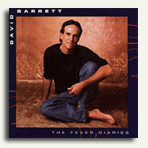
Songwriter David Barrett lives in Ann Arbor, Michigan. If you watch college basketball on television then you have probably heard David’s work. From David’s site: “The song is “One Shining Momentâ€â€”the paean to endeavor that now crowns the NCAA Basketball Finals.” I have only met David once while he visited Austin, but found him to be soft spoken with a kindly and considerate demeanor living a clearly examined life. He’s the guy you wish could have a larger voice in the world of music. I hope you will visit David’s site to learn more about this talented man.
David and I met through my long time friend and colleague Helen Darling. Like most of us, David loves the way Helen sings. Helen brought in an mp3 of David’s song, “Sleeping with the Blues” which we imported into Digital Performer in preparation of her vocal. David’s lead vocal was previously recorded and Helen added a quasi duet and additional backgroud treatments to enhance the lyric. I then compiled Helen’s performance into a single file called a soundbite, one soundbite for each of the three tracks she performed (three part harmony, thusly three tracks).
I recorded Helen’s vocal with a Mojave MA-200, the new David Royer cardioid tube microphone. It was run through a Peavey VMP-2 tube mic-pre and a Manley Vari-Mu tube compressor before hitting the A/D convertors in the MOTU 2408MK3. This is my new favorite microphone and signal path for about 90% of the Austin studio singers who work with me here. Thank you, David, for trusting Helen and me with another one of your great songs. Thank you, Helen, for another musically rewarding and fun day!
by Gary Powell, Vocal Producer

Songwriter David Barrett lives in Ann Arbor, Michigan. If you watch college basketball on television then you have probably heard David’s work. From David’s site: “The song is “One Shining Momentâ€â€”the paean to endeavor that now crowns the NCAA Basketball Finals.” I have only met David once while he visited Austin, but found him to be soft spoken with a kindly and considerate demeanor living a clearly examined life. He’s the guy you wish could have a larger voice in the world of music. I hope you will visit David’s site to learn more about this talented man.
David and I met through my long time friend and colleague Helen Darling. Like most of us, David loves the way Helen sings. Helen brought in an mp3 of David’s song, “Sleeping with the Blues” which we imported into Digital Performer in preparation of her vocal. David’s lead vocal was previously recorded and Helen added a quasi duet and additional backgroud treatments to enhance the lyric. I then compiled Helen’s performance into a single file called a soundbite, one soundbite for each of the three tracks she performed (three part harmony, thusly three tracks).
I recorded Helen’s vocal with a Mojave MA-200, the new David Royer cardioid tube microphone. It was run through a Peavey VMP-2 tube mic-pre and a Manley Vari-Mu tube compressor before hitting the A/D convertors in the MOTU 2408MK3. This is my new favorite microphone and signal path for about 90% of the Austin studio singers who work with me here. Thank you, David, for trusting Helen and me with another one of your great songs. Thank you, Helen, for another musically rewarding and fun day!
Belmont University Student
Seeks Career Advice for the
Professional Recording Session Singer
Professional Recording Session Singer
Mr. Powell, thank you SO much again for agreeing to answer my questions on such short notice. I am really excited to learn more about professional studio singing. You can answer the following questions to any extent that you see fit. I will appreciate any wisdom that you feel to pass on to me. Thanks again!
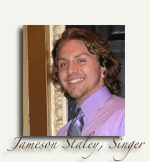
Jameson Staley,
Commercial Vocal Major
(Performance and Composition/Arranging Emphases)
Survey of Music Business 1110/Dr. Larry E. Wacholtz, Instructor
Belmont University, Nashville, TN
1. In your opinion, what qualities (musical and personal) are absolutely necessary for a professional studio singer?
Let’s take the musical skills first. Most recording session work for vocalists is performed within some pre-existing recorded musical context. In the studio environment, the best “ear†is advantaged over the best “voiceâ€. This means I favor singers who can match tone, style, take both melodic and phrasing dictation and vocally respond to many other sculpting tools I employ. The “ear†to “voice†connection must be strong in order to succeed. My best singers are capable of my loading them with a dozen or so performance nuances or “commands†and then immediately sing them as requested…IN-TUNE!
Regarding personal qualities, learning one’s own psychology is a long road. Management gurus say we “hire for skills†and “fire for aptitude†when it should be the other way around. I can teach a singer the skills they need if they have the aptitude and temperament to learn. Not every singer is up for this regardless of their “great voiceâ€.
2. Do you prefer to employ vocalists who specialize in a particular style of singing and hire them according to the project at hand or to use versatile singers that are experienced in various genres and styles?
Both! Singers who are musically adept across different genres will get more calls for session work. I would add that the ability to sing these differing styles within a vocal ensemble is even more important.
In my Austin studio, I have an equal distribution of solo, background vocal and choral work. All the singers I record have a natural strength stylistically. But remember, a totally unique voice may not be hired as often as a strong utilitarian instrument….. regardless of their talent.
3. How many passes should it take for a good vocalist to lay down a track?
Every vocal producer does this differently. I don’t favor the “multiple pass†and “comp†(compile) it later method. I will sometimes use this method when recording an inconsistent singer or helping a singer who is not feeling well.
Typically, in a solo vocal session, I will first play the song for the vocalist which usually does not have a scratch (demo) vocal take. I next make sure we are in agreement about what notes to sing, discuss the interpretation and then leave them alone for about ten minutes giving them the ability to review at their own pace. If I have written the song, I’m more likely to play through it at the piano before introducing the recorded tracks to the singer. In any case, I have learned that it’s important to remove any judgment from the room while the singer is integrating the piece into their very personal instrument. This is why I leave them to do this alone. After we get levels, I expect to have a workable performance within fifteen minutes or less. I am more likely to work and sculpt one solid and complete performance into a great performance phase by phrase. The relationship between performer and producer is complex, but be sure that I will try at some point to help the singer feel musically unshackled.
4. Are most studio singers trained in vocal technique (classically or in contemporary styles) or are many just naturally talented singers without formal training? What are things you like/dislike about each?
Most singers who work in my studio have had some organized vocal ensemble experience. I do hire singers who are trained classical singers. Occasionally, in a small choral ensemble situation, I will hire four “bel-canto†classical voices for size and four of my best “ear†singers for their speed in integrating the ensemble sound.
I love singers and will do everything to make their stay with me a pleasant and productive one. In my perfect world, the classical singers would have better ears and the “ear†singers would read music.
5. What are the best experiences from which singers can gain knowledge and maturity in order to become good studio vocalists?
A choral experience either in high school or later is very helpful, IF they are not forced to produce a sound for which their voice isn’t suited. Choral directors are famous for wanting a bigger sound than the student voices are ready for. This guarantees these singers will be disabled from other forms of vocal expression. I could and may write a book on this as it is a topic on which I feel strongly.
This is important! Many producers don’t write or read music. As a singer myself in other studios, I have never been handed a vocal chart. Never.
However, I will always write a chart for the sessions at my studio unless it’s a three-part texture that I can do more quickly by ear or by what we call a “head-chartâ€. I will always know the exact notes I want sung whether I write them or not. You, however, at other studios will often be asked to “find†your own parts. This excavating for a vocal arrangement can be an unnerving process if not prepared. Know it WILL happen and if navigated successfully, your skills will become an important asset to the producer who is not comfortable with this part of the production.
6. Do you pay your vocalists more or less money per session based on their ability or the difficulty of the job at hand, or do you pay them all at the same rate?
Pay scale is determined largely by budget, difficulty, and session duration (for “group singsâ€). Ensemble singers are always paid the same within each session regardless of my existing relationship with individuals. If I determine they are good enough to use in a session, then I feel they deserve the same pay. That said, I really prefer not to introduce a new singer into an ensemble situation until knowing their voice very well.
Twenty years ago, I hired a saxophone section to play a swing arrangement I had written for “Jingle Bell Rockâ€. There was one read-through, one pass for phrasing and by the third pass we were done. The whole session took twenty minutes. At the time I think they were paid the minimum of $75 each.
That night three female singers came in to record a three-part texture of ONLY the bridge of the song. The parts were difficult and they were young and inexperienced. I remember they made $180 each. It was clear that being inadequate and slow paid more than competence and experience. I never pay strictly by the clock anymore. I budget what I think is a reasonable time for the session, then pay a flat rate usually based per song. There are now bonuses for beating the clock…. not stretching it. Fees are announced preceding, during and after each session. Nobody, including me, should be left in the dark about compensation.
7. How does a studio singer begin a career? What steps need to be taken to find work?
First of all, if a singer expects to do this as their sole source of income, then move to a city where this is possible……probably Chicago, L.A., New York or Nashville. Locate the jingle houses first. Nothing pays singers as well as jingle production other than stardom which is different topic altogether.
Show up! Listen. Learn. Adapt! Show up again! Repeat cycle for the rest of your life. (This advice is not just for studio singers!)
8. Is studio singing a solid enough career that someone could make their living from singing sessions alone? Is this only for the highest-paid, “first call” singers, or is this a realistic goal for many studio singers?
Yes, there are recording session singer careers out there, but you must choose a city where it exists. “First call†singers will be the only ones not having to supplement their income with other jobs. Things get more complicated as you enter markets like New York, but so does getting an apartment and buying groceries.
9. What is the single most important piece of advice you could give to young singers looking to be studio vocalists?
I don’t have a single piece of advice. Life experience cannot be reduced to a single piece of advice. If someone can do that then they are probably just wishing it were so. I wish it were that simple too. That said, here is your starter kit.
Learn the difference between a dream and an aspiration.
Open an IRA. If needed, skip two pizzas per month to fund it. Never quit funding it. There’s no retirement for most of us at the end of this music career, so take care of yourself. It’s your life, so it’s your responsibility. It’s that simple.
Strive for honesty with yourself and with the people you are asking to help you.
Take a look at your arrogance. Most of us singers have it. It’s our biggest obstacle.
Be both ambitious and fair in all matters professional and personal.
Thank you, Jameson, for your sincere and pertinent questions. My best for success in your life and career.
–Gary Powell
Mr. Powell, thank you SO much again for agreeing to answer my questions on such short notice. I am really excited to learn more about professional studio singing. You can answer the following questions to any extent that you see fit. I will appreciate any wisdom that you feel to pass on to me. Thanks again!

Jameson Staley,
Commercial Vocal Major
(Performance and Composition/Arranging Emphases)
Survey of Music Business 1110/Dr. Larry E. Wacholtz, Instructor
Belmont University, Nashville, TN
1. In your opinion, what qualities (musical and personal) are absolutely necessary for a professional studio singer?
Let’s take the musical skills first. Most recording session work for vocalists is performed within some pre-existing recorded musical context. In the studio environment, the best “ear†is advantaged over the best “voiceâ€. This means I favor singers who can match tone, style, take both melodic and phrasing dictation and vocally respond to many other sculpting tools I employ. The “ear†to “voice†connection must be strong in order to succeed. My best singers are capable of my loading them with a dozen or so performance nuances or “commands†and then immediately sing them as requested…IN-TUNE!
Regarding personal qualities, learning one’s own psychology is a long road. Management gurus say we “hire for skills†and “fire for aptitude†when it should be the other way around. I can teach a singer the skills they need if they have the aptitude and temperament to learn. Not every singer is up for this regardless of their “great voiceâ€.
2. Do you prefer to employ vocalists who specialize in a particular style of singing and hire them according to the project at hand or to use versatile singers that are experienced in various genres and styles?
Both! Singers who are musically adept across different genres will get more calls for session work. I would add that the ability to sing these differing styles within a vocal ensemble is even more important.
In my Austin studio, I have an equal distribution of solo, background vocal and choral work. All the singers I record have a natural strength stylistically. But remember, a totally unique voice may not be hired as often as a strong utilitarian instrument….. regardless of their talent.
3. How many passes should it take for a good vocalist to lay down a track?
Every vocal producer does this differently. I don’t favor the “multiple pass†and “comp†(compile) it later method. I will sometimes use this method when recording an inconsistent singer or helping a singer who is not feeling well.
Typically, in a solo vocal session, I will first play the song for the vocalist which usually does not have a scratch (demo) vocal take. I next make sure we are in agreement about what notes to sing, discuss the interpretation and then leave them alone for about ten minutes giving them the ability to review at their own pace. If I have written the song, I’m more likely to play through it at the piano before introducing the recorded tracks to the singer. In any case, I have learned that it’s important to remove any judgment from the room while the singer is integrating the piece into their very personal instrument. This is why I leave them to do this alone. After we get levels, I expect to have a workable performance within fifteen minutes or less. I am more likely to work and sculpt one solid and complete performance into a great performance phase by phrase. The relationship between performer and producer is complex, but be sure that I will try at some point to help the singer feel musically unshackled.
4. Are most studio singers trained in vocal technique (classically or in contemporary styles) or are many just naturally talented singers without formal training? What are things you like/dislike about each?
Most singers who work in my studio have had some organized vocal ensemble experience. I do hire singers who are trained classical singers. Occasionally, in a small choral ensemble situation, I will hire four “bel-canto†classical voices for size and four of my best “ear†singers for their speed in integrating the ensemble sound.
I love singers and will do everything to make their stay with me a pleasant and productive one. In my perfect world, the classical singers would have better ears and the “ear†singers would read music.
5. What are the best experiences from which singers can gain knowledge and maturity in order to become good studio vocalists?
A choral experience either in high school or later is very helpful, IF they are not forced to produce a sound for which their voice isn’t suited. Choral directors are famous for wanting a bigger sound than the student voices are ready for. This guarantees these singers will be disabled from other forms of vocal expression. I could and may write a book on this as it is a topic on which I feel strongly.
This is important! Many producers don’t write or read music. As a singer myself in other studios, I have never been handed a vocal chart. Never.
However, I will always write a chart for the sessions at my studio unless it’s a three-part texture that I can do more quickly by ear or by what we call a “head-chartâ€. I will always know the exact notes I want sung whether I write them or not. You, however, at other studios will often be asked to “find†your own parts. This excavating for a vocal arrangement can be an unnerving process if not prepared. Know it WILL happen and if navigated successfully, your skills will become an important asset to the producer who is not comfortable with this part of the production.
6. Do you pay your vocalists more or less money per session based on their ability or the difficulty of the job at hand, or do you pay them all at the same rate?
Pay scale is determined largely by budget, difficulty, and session duration (for “group singsâ€). Ensemble singers are always paid the same within each session regardless of my existing relationship with individuals. If I determine they are good enough to use in a session, then I feel they deserve the same pay. That said, I really prefer not to introduce a new singer into an ensemble situation until knowing their voice very well.
Twenty years ago, I hired a saxophone section to play a swing arrangement I had written for “Jingle Bell Rockâ€. There was one read-through, one pass for phrasing and by the third pass we were done. The whole session took twenty minutes. At the time I think they were paid the minimum of $75 each.
That night three female singers came in to record a three-part texture of ONLY the bridge of the song. The parts were difficult and they were young and inexperienced. I remember they made $180 each. It was clear that being inadequate and slow paid more than competence and experience. I never pay strictly by the clock anymore. I budget what I think is a reasonable time for the session, then pay a flat rate usually based per song. There are now bonuses for beating the clock…. not stretching it. Fees are announced preceding, during and after each session. Nobody, including me, should be left in the dark about compensation.
7. How does a studio singer begin a career? What steps need to be taken to find work?
First of all, if a singer expects to do this as their sole source of income, then move to a city where this is possible……probably Chicago, L.A., New York or Nashville. Locate the jingle houses first. Nothing pays singers as well as jingle production other than stardom which is different topic altogether.
Show up! Listen. Learn. Adapt! Show up again! Repeat cycle for the rest of your life. (This advice is not just for studio singers!)
8. Is studio singing a solid enough career that someone could make their living from singing sessions alone? Is this only for the highest-paid, “first call” singers, or is this a realistic goal for many studio singers?
Yes, there are recording session singer careers out there, but you must choose a city where it exists. “First call†singers will be the only ones not having to supplement their income with other jobs. Things get more complicated as you enter markets like New York, but so does getting an apartment and buying groceries.
9. What is the single most important piece of advice you could give to young singers looking to be studio vocalists?
I don’t have a single piece of advice. Life experience cannot be reduced to a single piece of advice. If someone can do that then they are probably just wishing it were so. I wish it were that simple too. That said, here is your starter kit.
Learn the difference between a dream and an aspiration.
Open an IRA. If needed, skip two pizzas per month to fund it. Never quit funding it. There’s no retirement for most of us at the end of this music career, so take care of yourself. It’s your life, so it’s your responsibility. It’s that simple.
Strive for honesty with yourself and with the people you are asking to help you.
Take a look at your arrogance. Most of us singers have it. It’s our biggest obstacle.
Be both ambitious and fair in all matters professional and personal.
Thank you, Jameson, for your sincere and pertinent questions. My best for success in your life and career.
–Gary Powell
Laura Benedict Scott, Singer/Singer/Singer
by Gary Powell
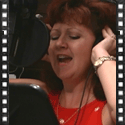
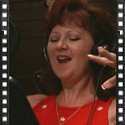

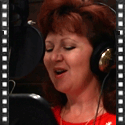
The first time I heard Laura Benedict Scott sing was in the mid 1980’s at an Austin club “Toulouse” on 6th Street. She had a commanding stage presence and was ripping Aretha Franklin’s “Think” like no other singer I had ever heard. Laura has been an important part of my studio ever since.
Laura has performed across the country with the popular Austin band, “Rotel and the Hot Tomotoes”, for twenty years. With them, Laura has made two separate appearances performing at the White House for President Bush. Laura has also been featured in starring roles at Zachary Scott Theatre Center, in Austin for the shows “Beehive”, “Rockin’ Christmas Party”, “Soul Sisters” and an amazing performance as Pasty Cline in “Always Patsy Cline”.
Laura is currently working with her new group Three Blondes, which is performing at Austin conventions and gala events. Her natural talent for R&B, session skills, work ethic and loyalty make her a “first-call” singer in my studio. I’m so proud to have Laura Benedict Scott associated with my long history as an Austin music producer.
These Laura Benedict Scott solo performances can be found on various Disney recordings and the other recordings listed below. Please note that I do not sell these recordings. For more information please go directly to Walt Disney Records or follow the links below for specific titles.
A Bug’s Life Sing Along
A PARENT’S CHOICE AWARD WINNER
“Rolly Poly Pillbug Rock ‘n Roll”
Dinosaur-Disney Song Factory
“Make Some Noise”
Disney’s Animal Songs
“Lucky, Lucky Snake”, “Rhinos, Rhinos Can’t Be Beat”, “Anteater”
Various Other Laura Benedict Scott Solo Performances for Walt Disney Records
“Home for the Holidays”, “So This is Love”, “The “Little” Medley”, “The Bunny Hop”, “The Silly Words of Christmas Time”, “The Swim”, “Rocking Around the Christmas Tree”
Chorus Performances for Walt Disney Records
“Black Widow Spider”, “I Won’t Say I’m in Love”, “Happy Birthday”, “Bibidibobbididoo”, “Shout”, “Morning’s Here”, “You’ve Got a Friend in Me”, “I Just Can’t Wait to Be King”, “Rocking Around the Christmas Tree”, “High Hopes”, “Ladybug”, “Flea-Ring Circus”, “Little Miss Muffit, Little Bo Peep Medley”, “Let’s All Roar Tonight”
Jingles
“Just Take the Keys” for the State of Texas, “Franklin Federal”
Miramar Productions
Kurt Van Sickle
Miramuse
“In My Palm”
by Gary Powell




The first time I heard Laura Benedict Scott sing was in the mid 1980’s at an Austin club “Toulouse” on 6th Street. She had a commanding stage presence and was ripping Aretha Franklin’s “Think” like no other singer I had ever heard. Laura has been an important part of my studio ever since.
Laura has performed across the country with the popular Austin band, “Rotel and the Hot Tomotoes”, for twenty years. With them, Laura has made two separate appearances performing at the White House for President Bush. Laura has also been featured in starring roles at Zachary Scott Theatre Center, in Austin for the shows “Beehive”, “Rockin’ Christmas Party”, “Soul Sisters” and an amazing performance as Pasty Cline in “Always Patsy Cline”.
Laura is currently working with her new group Three Blondes, which is performing at Austin conventions and gala events. Her natural talent for R&B, session skills, work ethic and loyalty make her a “first-call” singer in my studio. I’m so proud to have Laura Benedict Scott associated with my long history as an Austin music producer.
These Laura Benedict Scott solo performances can be found on various Disney recordings and the other recordings listed below. Please note that I do not sell these recordings. For more information please go directly to Walt Disney Records or follow the links below for specific titles.
A Bug’s Life Sing Along
A PARENT’S CHOICE AWARD WINNER
“Rolly Poly Pillbug Rock ‘n Roll”
Dinosaur-Disney Song Factory
“Make Some Noise”
Disney’s Animal Songs
“Lucky, Lucky Snake”, “Rhinos, Rhinos Can’t Be Beat”, “Anteater”
Various Other Laura Benedict Scott Solo Performances for Walt Disney Records
“Home for the Holidays”, “So This is Love”, “The “Little” Medley”, “The Bunny Hop”, “The Silly Words of Christmas Time”, “The Swim”, “Rocking Around the Christmas Tree”
Chorus Performances for Walt Disney Records
“Black Widow Spider”, “I Won’t Say I’m in Love”, “Happy Birthday”, “Bibidibobbididoo”, “Shout”, “Morning’s Here”, “You’ve Got a Friend in Me”, “I Just Can’t Wait to Be King”, “Rocking Around the Christmas Tree”, “High Hopes”, “Ladybug”, “Flea-Ring Circus”, “Little Miss Muffit, Little Bo Peep Medley”, “Let’s All Roar Tonight”
Jingles
“Just Take the Keys” for the State of Texas, “Franklin Federal”
Miramar Productions
Kurt Van Sickle
Miramuse
“In My Palm”
